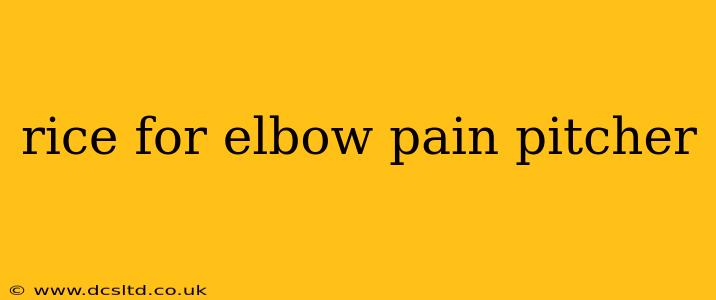Elbow pain is a common ailment, particularly for athletes, and pitchers are especially susceptible. The repetitive stress on the elbow joint during pitching can lead to various conditions like golfer's elbow (medial epicondylitis), tennis elbow (lateral epicondylitis), and even more serious injuries. Many seek natural remedies, and RICE therapy often comes up in the conversation. But is RICE truly effective for elbow pain in pitchers? Let's delve into the details.
What is RICE Therapy?
RICE stands for Rest, Ice, Compression, and Elevation. It's a widely recommended first-aid treatment for soft tissue injuries like sprains, strains, and bruises. Let's examine how each component applies to elbow pain in pitchers:
Rest: The Crucial First Step for Pitcher's Elbow
Rest is arguably the most important aspect of RICE for elbow pain. Pitchers need to avoid activities that aggravate the pain, especially throwing. This allows the injured tissues to heal and reduces further inflammation. This doesn't necessarily mean complete inactivity; gentle range-of-motion exercises, as advised by a physical therapist or doctor, might be incorporated gradually. The key is to avoid anything that causes sharp pain.
Ice: Reducing Inflammation and Pain
Applying ice to the affected elbow helps reduce pain and inflammation. Ice constricts blood vessels, limiting swelling. Ice should be applied for 15-20 minutes at a time, several times a day, ensuring a thin barrier (like a towel) is placed between the ice and the skin to prevent frostbite.
Compression: Minimizing Swelling
Compression, using a bandage or sleeve, helps to minimize swelling and provides support to the elbow joint. The compression should be snug but not overly tight, as this can restrict blood flow. Compression also helps to keep the ice pack in place during application.
Elevation: Enhancing Drainage
Elevating the injured elbow above the heart helps to promote drainage of excess fluid, reducing swelling. While resting, try to keep your elbow elevated on pillows.
Does RICE Work for All Elbow Pain in Pitchers?
While RICE is a useful first-aid measure, it's crucial to understand its limitations. RICE is most effective for acute injuries, such as a sudden strain or sprain. For chronic conditions like tennis or golfer's elbow, RICE might provide temporary relief but is not a cure. In such cases, RICE should be combined with other treatments like physical therapy, stretching, strengthening exercises, and possibly even medical intervention.
How Long Should I Use RICE?
The duration of RICE therapy depends on the severity of the injury and individual response. For minor injuries, a few days of RICE might suffice. However, for more severe injuries, it might be necessary for several weeks. It’s vital to consult a doctor or physical therapist for guidance. Ignoring persistent pain can lead to long-term problems.
When Should I See a Doctor for Elbow Pain?
You should seek medical attention if:
- The pain is severe and doesn't improve with RICE.
- You experience numbness or tingling in your hand or fingers.
- You have limited range of motion in your elbow.
- The pain is accompanied by swelling, redness, or warmth.
- The pain persists for more than a few days.
What Other Treatments Are Available for Pitcher's Elbow?
Beyond RICE, various treatments are available for elbow pain in pitchers, including:
- Physical therapy: This involves exercises to improve strength, flexibility, and range of motion.
- Medication: Over-the-counter pain relievers like ibuprofen or naproxen can help reduce pain and inflammation. In some cases, a doctor might prescribe stronger medications.
- Injections: Corticosteroid injections can help reduce inflammation, but they're not a long-term solution.
- Surgery: In rare cases, surgery may be necessary to repair damaged tendons or ligaments.
Remember, RICE is a first aid treatment; it's not a standalone solution for all elbow pain. Always consult a medical professional for a proper diagnosis and treatment plan. They can assess the severity of your injury and recommend the most appropriate course of action. Self-treating can delay proper healing and may even worsen the condition. Prioritize proper diagnosis and professional guidance for optimal recovery.
